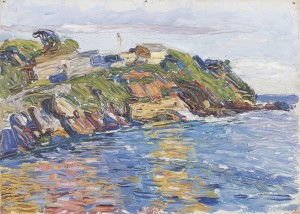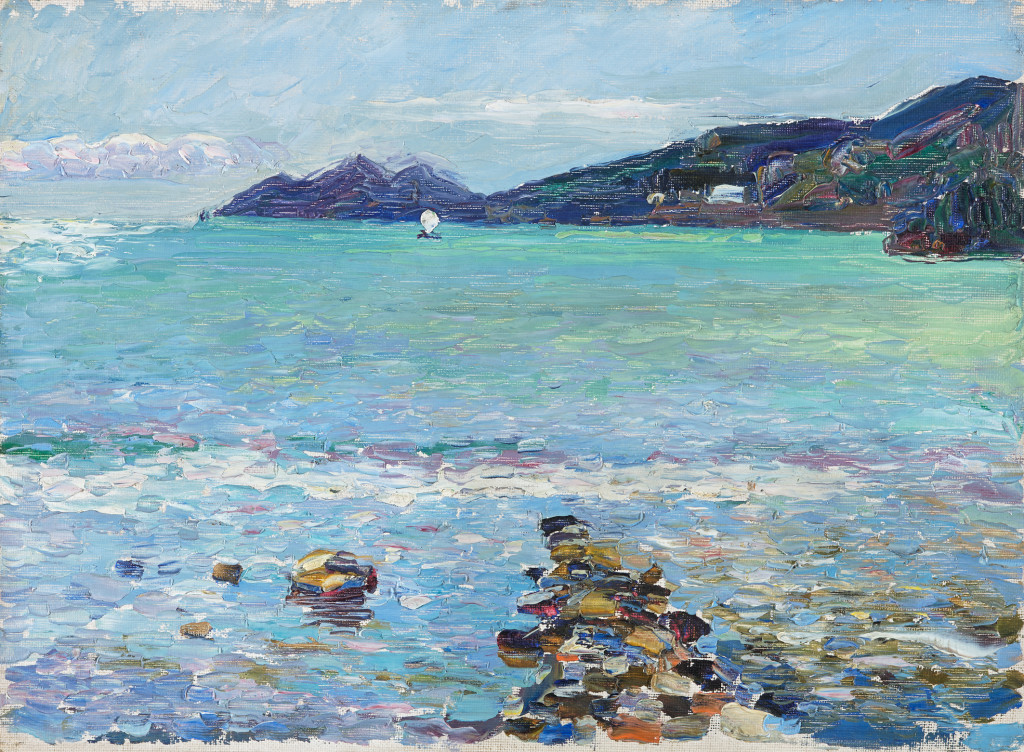Wassily Kandinsky (Moscow 1866 - 1944 Neuilly-sur-Seine)
Portofino seen from Rapallo, c.1906
Oil on canvas, laid down on cardboard, 23.5 x 32 cm
Inscribed by Gabriele Münter on the verso Kandinsky / Rapallo 1906 Portofino von Rapallo
Provenance:
Gabriele Münter, Murnau
Galerie Franz Resch, Gauting, 1961
Georg Schäfer private collection, Schweinfurt
German private collection
Exhibited:
Kandinsky und Gabriele Münter. Werke aus fünf Jahrzehnten, Munich, Städtische Galerie im Lenbachhaus, February-March 1957, Munich 1957, no.41 (not repr.)
Der frühe Kandinsky. 1900-1910, Berlin, Brücke Museum, September-November 1994; Tübingen, Kunsthalle, December 1994-February 1995, Munich 1994, no. 18, repr.
Wassily Kandinsky, Tra Monaco e Mosca. 1896-1921, Rome, Museo Centrale del Risorgimento al Vittoriano, October 2000-February 2001, Rome 2000, p. 70, repr.
Literature:
Hans K. Roethel and Jean Benjamin, Kandinsky. Werkverzeichnis der Ölgemälde 1900-1944, Munich 1982, I, p. 167, no. 158, repr.
Natascha Niemeyer-Wasserer, Wassily Kandinsky und die Malerei des russischen Symbolismus in den formativen Jahren 1896-1907. Eine vergleichende Studie, PhD Diss., LMU Munich 2006, p. 259, fig. 73: https://edoc.ub.uni-muenchen.de/7973/1/Niemeyer-Wasserer_Natascha.pdf, (accessed 11.01.16)
Massimo Brignardi, Kandinskij in Italia: tra ricordo e visione, alla ricerca di una “nuova qualità” del colore, Annali Online di Ferrara, Lettere, I-II (2011), pp. 401-4, fig. 17, p. 413: http://annali.unife.it/lettere/article/viewFile/261/210, (accessed 11.01.16)
Kandinsky first met Gabriele Münter, eleven years his junior, when she began taking classes at an avant-garde painting school attached to the artists’ association named ‛Phalanx’ in 1902. Kandinsky had co-founded the association in Munich in 1901. In 1904 Kandinsky and Münter set off on an extensive tour of Europe, visiting Holland, Italy and Tunisia. They were in Rapallo between December 1905 and April 1906 and would later travel on to Sèvres near Paris, where they spent almost a year.

Fig. 1 Wassily Kandinsky, Bay of Rapallo, 1906, oil on card, 23.9 x 33 cm, Munich, Städtische Galerie im Lenbachhaus
This small oil painting was executed in Rapallo on the Ligurian coast. The art historian Vivian Endicott Barnett, writing in 1995, notes: Kandinsky painted views from the house they had rented on Via Montebello [...] and a large number of views of the bay. Pastel colours dominate in his Italian landscapes, and his use of paint is noticeably freer […]. The brilliance of Tunisian and Italian light was to cause a gradual lightening of his palette.[1] By 1906 he had already mastered the technique of juxtaposing tiny dots and dabs of paint. He placed them in delicate tonal gradation or in expressive contrast to one another (Fig. 1).[2]
This painting is a very fine example of the plein-air paintings Kandinsky produced in this technique. It was the landscape studies of the years 1905-6, which, like the present painting, were the forerunners of the ‘singing landscapes’ produced in Murnau. Here, the castles and hilltop towers of his landscapes were replaced with stabs of paint or, as he saw them, musical notes and chords that would ‘sing’ together. This marked the beginning of his journey into abstraction and the elimination of all representational content.
[1] Vivian Endicott Barnett, ‘Ausgedehnte Reisen. 1904 - 1906’, in Helmut Friedel and Marion Ackermann (eds.), Das bunte Leben. Die Geschichte der Sammlung von Wassily Kandinskys Werken im Lenbachhaus, Munich 1995, p. 127.
[2] See Der frühe Kandinsky. 1900-1910, Magdalena Moeller and Vivian Endicott Barnett (eds.), exhib. cat., Berlin, Brücke-Museum, September-November 1994; Tübingen, Kunsthalle, December 1994 - February 1995, Munich 1994, nos. 16-20.

